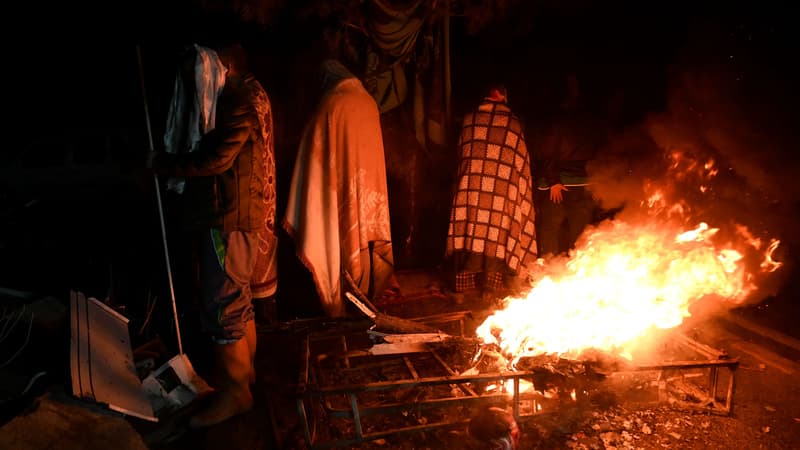The race against time and cold continued through the night from Monday to Tuesday in Turkey and northern Syria to rescue survivors of violent earthquakes that devastated the region on Monday, killing several thousand people.
According to the latest official report – which will probably be stronger – almost twenty hours after the first of three tremors, with a magnitude of 7.8 that was felt as far away as Lebanon, Cyprus and northern Iraq, more than 5,000 People were killed, including 3,419 in Turkey according to the public disaster management body (Afad), and more than 1,500 in Syria.
In the cold and with bare hands
In order to save lives, the emergency services dispatched to the scene must also fight against the cold, in the pouring rain or snow, sometimes with their bare hands. The bad weather that hangs over Anatolia complicates the rescue task and makes the fate of the survivors even more bitter, shivering in tents or around improvised braziers.
International aid to Turkey should start arriving on Tuesday with the first rescue teams, in particular from France and Qatar. US President Joe Biden has promised his counterpart, Recep Tayyip Erdogan, “all the necessary help, whatever it may be.”
The French planned to go in particular to Kahramanmaras, the epicenter of the first quake, a hard-to-reach and deeply bruised region, also buried under snow. Two US detachments of 79 rescuers each were preparing to go there on Monday, according to the White House. According to the Turkish president, 45 countries have offered their help.
Act fast despite the conditions
On Monday, David Annotel, a representative of the French National Federation of Firefighters, explained on BFMTV the need for this international solidarity and the need for rapid deployment of rescuers to the scene due to weather conditions.
“Every minute every hour begins to count, the weather is particularly unfavorable in this winter period. It is important that foreign rescue services such as reinforcements can be in place quickly,” he argued.
Patrick Coulombel, co-founder of the Architectes de l’urgence foundation, made this image even more striking. “The absolute priority is to try to recover the people who are under the rubble” but “the temperature conditions there are still not very good,” he insisted on BFMTV, before illustrating:
“We are in the middle of winter, it is a few degrees or even at night it is -2, -3, -4 degrees. It’s something that’s going to be extremely complicated.”
The survival of the people trapped under the rubble “will be very precarious if we do not intervene quickly,” stressed Patrick Colombel.
And intervention is even more problematic in Syria, which is increasingly torn by war. L’appel lancé par les autorités de Damas a été surtout entendu par son allié russe, promettant des équipes de secours “dans les prochaines heures”, alors que selon l’armée, plus 300 militaires russes sont déjà sur les lieux pour aider les rescue.
The UN also reacted, but insisted that the aid delivered would go “to all Syrians throughout the territory”, part of which is not under the control of Bashar al-Assad’s power.
the cold will last
Balances on both sides of the border have continued to rise and, given the extent of the damage, should increase as the search progresses. In Turkey alone, the authorities have counted almost 5,000 collapsed buildings. And the drastic drop in temperatures puts the injured, trapped in the ruins, at additional risk of hypothermia.
Especially since the thaw is not for now. In the Idlib region, the Syrian province affected by the earthquake, the thermometer will not exceed 5°C during the day on Tuesday, and rather will drop to 2°C the next night. On Wednesday and Thursday, the trends will deteriorate further, with 1°C and 0 to -1°C respectively… during the day. The nights will be less cold, however, recovering a few degrees.
On the Turkish side, the cold will continue to bite near the epicenter of the quake, around Kahramanmaras. The city woke up below 2°C on Tuesday morning and temperatures of 0°C were recorded. In and around Pazarcik, night temperatures may drop to -3°C the next night. It will be nothing compared to Wednesday: -1°C during the day in Kahramanmaras, and even -7°C in Pazarcik, where it will still be -5°C at night.
The World Health Organization itself said it expected the worst, fearing “tolls eight times higher than initial numbers.” However, not only because of the temperatures, but also because of the new tremors. No less than 185 aftershocks were registered on Monday, after the first two tremors. And there were still several aftershocks on Tuesday night before dawn.
Source: BFM TV


